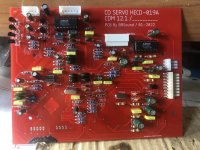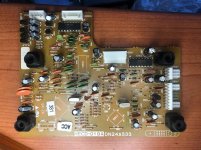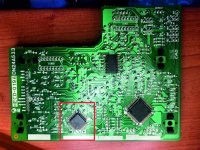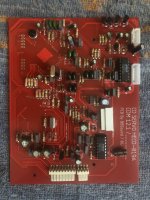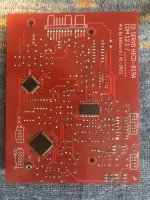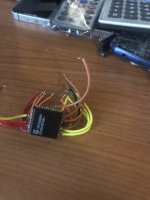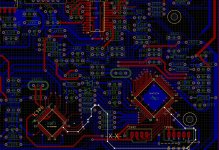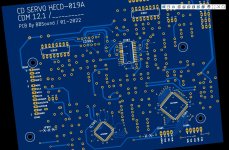I cloned the HECD-019A servo board for the tested and working Philips CDM12.1 mechanics.
Now I find myself with a problem.
I had to remove the P87C58 micro controller from the original board because the LQFP44 version is not for sale, I was able to find the PLCC44 version chip that I mounted on the new PCB but it does not work and therefore to make the prototype board work I had to remove it from the original board .
Now a doubt arises, does anyone know if this Philips controller, the P87C58 has a part of memory and therefore must be programmed?
Thanks for your help!
Now I find myself with a problem.
I had to remove the P87C58 micro controller from the original board because the LQFP44 version is not for sale, I was able to find the PLCC44 version chip that I mounted on the new PCB but it does not work and therefore to make the prototype board work I had to remove it from the original board .
Now a doubt arises, does anyone know if this Philips controller, the P87C58 has a part of memory and therefore must be programmed?
Thanks for your help!
Attachments
Just a question : why ?I cloned the HECD-019A servo board for the tested and working Philips CDM12.1 mechanics.
Now I find myself with a problem.
I had to remove the P87C58 micro controller from the original board because the LQFP44 version is not for sale, I was able to find the PLCC44 version chip that I mounted on the new PCB but it does not work and therefore to make the prototype board work I had to remove it from the original board .
Now a doubt arises, does anyone know if this Philips controller, the P87C58 has a part of memory and therefore must be programmed?
Thanks for your help!
because I am designing a customizable cd / dac player with both tubes and transistors with this mechanism which in my opinion is reliable and "cheap" and easy to find the laser, based on a simple and functional Audio Fidelity CD A3.5 project and firmware copyable to a Pic 16F88 that I have already done.Just a question : why ?
The problem with the servo controller of the mechanics is this 32K Philips P87C58 eeprom, as well as not being easy to find in the LQFP format I found it in PLCC version with different pinout and mounted respecting the pins but it doesn't work.
My question is if this P87C58 is programmed or if it initializes and only serves to store the axial parameters of the laser and the CD reading data.
Unfortunately the wiring diagram of the mechanics is not available on the web, this is the reason for the question.
Ok, that's a good reason.
I really would have liked to answer but I didn't go deep enough in the matrix for that.
I wish someone here would do it, it's an interesting project.
I really would have liked to answer but I didn't go deep enough in the matrix for that.
I wish someone here would do it, it's an interesting project.
but in fact it would be a good reason to be able to develop this project precisely because the mechanics are reliable and the firmware and hardware are easy to develop.Ok, that's a good reason.
I really would have liked to answer but I didn't go deep enough in the matrix for that.
I wish someone here would do it, it's an interesting project.
I forgot to say that I would have ordered the Eeprom 87C52 which would be the 256k version, the P87C58 is instead 32K, the format and the connection pins of the two Eeproms are identical LQFP, they differ only for the memory.
If anyone has any ideas let me know in the meantime I will keep you informed on the developments of the project.
I cloned the HECD-019A servo board for the tested and working Philips CDM12.1 mechanics.
Now I find myself with a problem.
I had to remove the P87C58 micro controller from the original board because the LQFP44 version is not for sale, I was able to find the PLCC44 version chip that I mounted on the new PCB but it does not work and therefore to make the prototype board work I had to remove it from the original board .
Now a doubt arises, does anyone know if this Philips controller, the P87C58 has a part of memory and therefore must be programmed?
Thanks for your help!
Yes, it needs to be programmed. The previous VCDs of Philips have mask rom program versions, but their pins are different. Their models are OM5234/OM5284, marked CDT612 or CDT713, which are all DSA protocol interfaces. There are many such boards in China, because VCD was very popular before DVD! Without this control chip, your board is useless. Ten years ago, there was a forum in China called CNDIY CLUB. They had a project (not open source) that used MCU to directly control SAA7324, but that forum was closed a few years ago.
Thanks for replying.Yes, it needs to be programmed. The previous VCDs of Philips have mask rom program versions, but their pins are different. Their models are OM5234/OM5284, marked CDT612 or CDT713, which are all DSA protocol interfaces. There are many such boards in China, because VCD was very popular before DVD! Without this control chip, your board is useless. Ten years ago, there was a forum in China called CNDIY CLUB. They had a project (not open source) that used MCU to directly control SAA7324, but that forum was closed a few years ago.
So the eeprom 87C58 as I imagined must be programmed.
The question now is whether the eeprom can be read or is it read-protected.
Reading on the database, the Eeprom is readable and writable so we hope can read the content.
Now you need to equip yourself with a programmer to read the Eeprom 87C58.
now it would be interesting to know if there is someone who has a HECD-019A board and a programmer available and see if it is possible to read the 87C58, unfortunately I don't have the programmer for this Philips Eeprom series.
On aliexpress I would have found this programmer for this type of memory but I would not want to waste money on anything.
TL866II Plus programmer
https://it.aliexpress.com/item/1005....0.0.435918fcIhkyDd&mp=1&gatewayAdapt=glo2ita
LQFP44 TQFP44 to DIP40 adapter
https://it.aliexpress.com/item/3241....0.0.4c0d18fciWeFes&mp=1&gatewayAdapt=glo2ita
Ciekawe rozwiązanie .Mam takie servo w cyrus cd6s ale chętnie bym kupił drugie na zapas
 English please.
English please."Interesting solution. I have such a servo in cyrus cd6s but I would like to buy a second one as a spare"
I have a problem that I can't solve, the philips marked Eprom P87C58SBBB. We need to find a way to copy the internal storage otherwise the project doesn't work. Better said, it works in case the Eprom Philips P85C58 is unsoldered from an original servo board and the Eprom soldered on the new board that I copied. The card I cloned works with all the chips I bought new.
I found a supplier who has a lot of P87C58SBBB in stock, so finding the philips Eprom is not a problem.
I found a supplier who has a lot of P87C58SBBB in stock, so finding the philips Eprom is not a problem.
1. you must connect 4 channel oscilloscope or logic analizer to pins 39, 40, 41, 42 and may be, 43 of servo SAA7327.
recording bus exchange while playing.
recording bus exchange while disk starting
recording bus exchange while power on servo initialising and autocalibrating
recording bus exchange while rewind and track change.
Its look difficultly, but its the good way.
2.I use simple Arduino IDE and Arduino UNO for starting. In finish, i use ATMEGA32A for control the servo. My scetch is free for use.
You must read SAA7327 datasheet paranoicaly from page 28 to page 48
all command on page 46 in table 17
I can help you to Q-CODE decoding and understand, TOC reading, and some disk reading sequence. My program was adapted to old YM7121c servo whithout automatic ajusting. But REDBOOK is still the same.
download the IEC_60908 or send me email for got it.
scetch -
https://www.diyaudio.com/community/attachments/cec_fw_0_1_0-zip.984577/
recording bus exchange while playing.
recording bus exchange while disk starting
recording bus exchange while power on servo initialising and autocalibrating
recording bus exchange while rewind and track change.
Its look difficultly, but its the good way.
2.I use simple Arduino IDE and Arduino UNO for starting. In finish, i use ATMEGA32A for control the servo. My scetch is free for use.
You must read SAA7327 datasheet paranoicaly from page 28 to page 48
all command on page 46 in table 17
I can help you to Q-CODE decoding and understand, TOC reading, and some disk reading sequence. My program was adapted to old YM7121c servo whithout automatic ajusting. But REDBOOK is still the same.
download the IEC_60908 or send me email for got it.
scetch -
https://www.diyaudio.com/community/attachments/cec_fw_0_1_0-zip.984577/
I haven't thought of that, it's a great idea.
In these days I will do some tests and I will be able to tell you what I got from the measurements:
-- POWER/START/AUTO
-- PLAY
-- NEXT
-- PREV
-- REW
A table of the parameters to be measured that you indicated to me will be created.
Thank very much
In these days I will do some tests and I will be able to tell you what I got from the measurements:
-- POWER/START/AUTO
-- PLAY
-- NEXT
-- PREV
-- REW
A table of the parameters to be measured that you indicated to me will be created.
Thank very much
Doing plaing disk no any control command, but only current status asked for every 12ms, and Q-code reading from servo.
Q-code subcode consists from current disk reading position - just track number, track time (min, sec, frame), disk time (min, sec, frame) pause marker, TNO marker.
Play mode is best for understending exchange protocol.
here is my logs as example
https://forum.vegalab.ru/showthread.php?t=87804&p=2787232&viewfull=1#post2787232
Q-code subcode consists from current disk reading position - just track number, track time (min, sec, frame), disk time (min, sec, frame) pause marker, TNO marker.
Play mode is best for understending exchange protocol.
here is my logs as example
https://forum.vegalab.ru/showthread.php?t=87804&p=2787232&viewfull=1#post2787232
regarding the pins connected to IC904, the SAA7327 as you can see on the PCB project that I created by copying the original servo PCB there is a connector with 5 pins connected to the CHIP at pins 39 40 38 44 42 which however exclude pin 43 which is not connected to nothing.
pin 41 does not go to the connector but directly to pin 42 of the IC906, the Philips P87C58 Eprom.

pin 41 does not go to the connector but directly to pin 42 of the IC906, the Philips P87C58 Eprom.
Attachments
Last edited:
- Home
- Source & Line
- Digital Source
- Clone SERVO CD HECD-019A for PHILIPS CDM12.1
